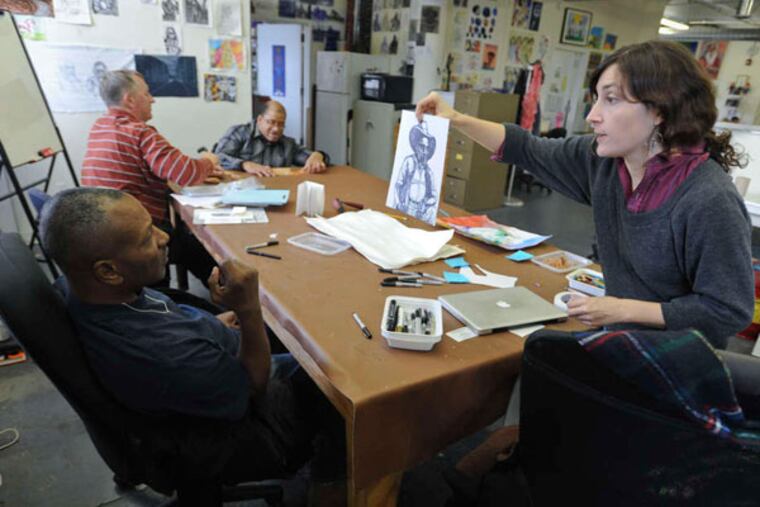An Oasis for the challenged
You'd recognize the faces: mob boss Tony Soprano, chemistry teacher-turned-meth-chef Walter White, and everyone's favorite dad, Homer Simpson. You may not recognize the name of the artist, Peter Somenshein, 28, of Narberth. But with his forthcoming solo show at the Oasis Art Center, that, too, may change.

You'd recognize the faces: mob boss Tony Soprano, chemistry teacher-turned-meth-chef Walter White, and everyone's favorite dad, Homer Simpson.
You may not recognize the name of the artist, Peter Somenshein, 28, of Narberth. But with his forthcoming solo show at the Oasis Art Center, that, too, may change.
"It's been really cool working with Peter," says Maggie Mills, one of the artists who instruct aspiring talents at Oasis in North Philadelphia. "He's made amazing progress in the time he's been here."
Somenshein is one of about 150 people a year with intellectual or developmental delays or mental health diagnoses who benefit from the Oasis program, which offers personal instruction in art, technology, literacy, and life skills.
Offered by Resources for Human Development, a nonprofit that serves people of all abilities in 14 states, Oasis is funded through a mix of fee-for-service payments, grants, and private donations.
"We encourage the development of new life skills, based on patience and opportunity," says Pat Lyons of Ivyland, Oasis' founder and director. "Not on meeting our expectations."
Along with painting and drawing, Oasis offers instruction in cooking and sewing. A new program in the business of art guides students in pricing, promoting, and marketing their work, with the goal of showing them how to package a portfolio and understand fiscal responsibility.
"It's the students' center," Lyons says. "They are fully included in all decisions around their art."
Working in small groups of one to six, students and a staff of 20 artists spread out around wooden tables in their airy, former warehouse space, heads bent over notepads and canvasses, sketching with ballpoint pens, pencils, or magic markers. Around and above them rise precisely rendered black-and-white and festively colored portraits, all part of the current public art exhibition at Oasis.
Betty Hartzell, a former assistant director of art therapy at Drexel University and a psychotherapist, says there can be "great benefits in art for individuals who are cognitively delayed."
"People can learn to organize material, which helps with problem-solving. Using materials in new ways can give people a sense of possibilities and the ability to make new choices," Hartzell says. "Working in small groups can also help cognitively delayed people to interact with others socially. And most importantly, art can give individuals a chance at self-expression."
Art created by Oasis community members is promoted and often sold at exhibitions. Oasis artists also have works in many private collections and have exhibited at the Sanford Smith Outsider Art Fair in New York, the world's foremost international marketplace for outsider art.
Seated at a work table, deep in concentration, Alonzo Humphrey, 53, of Philadelphia, applies pen to paper, creating yet another of his signature portraits, whose intense expressiveness belies the quickness of their execution. Clutching his pen with a sure hand, he sketches in the outline of a new work with amazing clarity of purpose. His work has sold for as much as $500.
Sometimes, says instructor/exhibitions coordinator Lucy Pistelli, it's as though he's channeling his subjects. According to his bio, Humphrey possesses an amazing visual memory, "mentally recording everything he sees through the process of drawing and then rehashing familiar imagery throughout his work."
Lyons, who has a degree from the University of the Arts, has worked with intellectually disabled individuals and art since 1996, starting with a small group of eight people.
"I saw an amazing change in my students," says Lyons, whose peripatetic program has been located at two homeless shelters and a Germantown church, among other places.
"We wanted to be integrated into the art world in Philadelphia," Lyons says. At Oasis' location on North 12th Street near Callowhill Street, that's very much the case. Tenants above and below them include architects, filmmakers, and musicians.
Another Oasis success story is Oranit Solomonov, 46, of Philadelphia, whose brilliantly colored pictures depict peacocks and jaguars, neighborhoods and airplanes.
Solomonov, whose work has sold in Philadelphia and New York for $350 to $400, exhibited many acting-out behaviors before entering the program. Born in Israel, she also had limited English skills. Thanks to her work with Oasis counselors, her speaking skills and behavior have vastly improved.
"But most importantly," Lyons says, "now she can identify herself as an artist. People see her differently, and she sees herself differently."
215-470-2998
@IRaymondRush